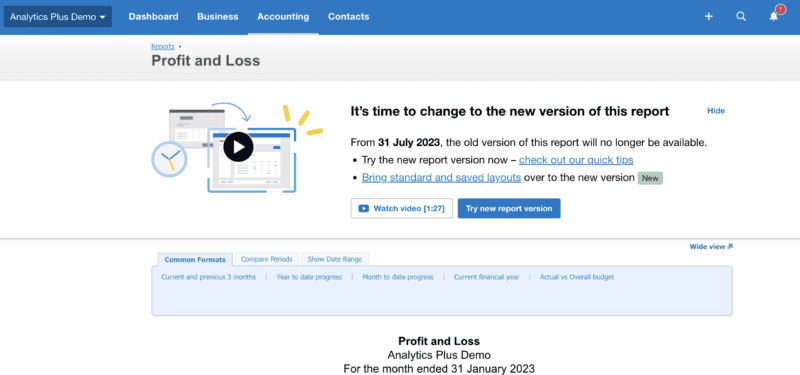
The retirement of old reports is now only a little over five months away. If you’re like many small business owners and advisors, you’re probably starting to seriously think about how this will impact your day-to-day work.
We’ve answered some of your most common questions, so you can feel confident about switching to new reports before 31 July 2023. Have another burning question? Our team are here to help — visit Xero Central for learning articles, support and more.
Q: Why are you getting rid of old reports?
We’ve had two versions of our reports for a while now — the older version and our ‘new’ reports. Our new reports are built on the latest technology and have some really exciting features that will help you get quick access to answers and streamline your financial analysis.
Our teams have big plans to add even more reports and functionality in the future. But to do this, they need to focus their attention on new reports, instead of spending their time maintaining older versions that are now outdated. That’s why we’re retiring the older versions of our reports in Xero.
Q: Why can’t we keep both versions?
All software has a lifecycle, like a car. The older it gets, the more challenging it becomes to maintain it. Even keeping the engine working requires effort, attention and cost. Eventually, you need to replace it with something new.
When it comes to reporting, it was time to upgrade. As we continue to build new products and features in Xero, we knew that soon it would no longer be possible to integrate them with the older versions of our reports — think of it like trying to plug an electric charger into a classic car.
Even if we left the older versions there unsupported, this lack of integration into other areas of Xero means the data would quickly become untrustworthy. Our vision is to be the most trusted and insightful small business platform, so it’s vital that the data in our reports is accurate.
Then there’s the question of resources. To maintain both products at a standard you expect, we’d need a full team working on the older version of our reports, which isn’t viable and would take us away from building the features that we know are important to you.
Basically, reporting is one of our most-loved products and a core part of the Xero platform, so it’s not something that we can keep as an outdated or unsupported version.
Q: How do I know I’m using the old version?
Good question! When you search for a report or view your favourites, you’ll see a tag letting you know it’s an old version.
These tags will continue to be added to old reports as more new reports become available. In the months ahead, the ‘Old version’ tag will change to ‘Retiring 31 July 2023’, so you know they won’t be available after that date.
When you open an older version of a report, you’ll see a banner at the top with links to the new version as well as tips to help you make the switch.

Q: What do I need to do before 31 July 2023?
If you want to use new reports just as they are, then all you need to do is open the report and get started! The tips and tricks panel in our most used reports and the reporting playlist on YouTube will help you get familiar with how they work.
Don’t forget to replace your favourites in the report centre with the new version of that report (we’ll start doing this for you soon, to help you make the switch).
If your reports are a little more complex, here are the key things you might need to do:
- Copy any custom layouts you may have using our layout importer tool linked at the top of the report (do this before 31 July as you won’t be able to after that date)
- Customise the new version if you want to, and save it as a custom report or default layout, so next time they’ll open exactly how you want them
- Finalise and publish any old saved report drafts, if you want to keep them as read only reports (draft reports will be removed after 31 July 2023)
- Connect any workflows outside Xero to the new versions of your reports (if you export data and do further manipulations in Excel or other apps to get what you need, like macros)
Q: What old reports will be available after 31 July 2023?
There are some old reports that won’t be retired on this date, as we are upgrading them in a different way or at a later date. These include:
- Budget Manager
- Business Activity Statement/GST/VAT/Sales Tax Return and Reconciliation reports
- Expense Claim Summary report
- Pay Run Summary and Pay Run by Employee, Pay Item and Pay Type reports (global organisations only)
- Foreign Currency Gains and Losses report
- Unrealised Gains and Losses report
- Tracking Summary report
- Budget Summary report
- Reporting API
Q: When will new reports have foreign currency?
Our new reports already convert foreign currency amounts to your base currency and do the appropriate revaluations and gain/loss calculations for financial reporting. The Account Transactions report also lets you view transactions in their original currency amounts.
We’re currently working on adding the ability to view transactions in their original currency amounts in more transactional style reports. Next, we’ll be working on adding the ability to translate Profit & Loss, Balance Sheet and Budget Variance reports into foreign currency.
Later, we’ll be creating a new Foreign Currency Gains and Losses report, including new Realised and Unrealised Gains and Losses drilldown reports, to replace the older versions. Don’t worry. We won’t be retiring the old reports until the new ones are available (even if it’s after 31 July 2023).
After 31 July 2023, we’ll be adding foreign currency disclosure notes in all new reports that apply.
Ready to switch?
We hope this answers some of your questions around the retirement of old reports! As always, we’re keen to hear your product ideas for future development, and here to help if you need a hand.
The post Why we can’t keep old reports (and other burning questions) appeared first on Xero Blog.
Leave a Reply